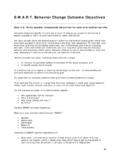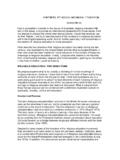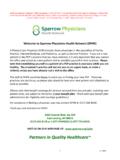Transcription of Competency Modeling competency - HR Strategic Partners
1 CONTACT GREG SEKOWSKI AT HR Strategic Partners , INC. FOR MORE INFORMATION Voice Fax E-mail WHAT IS Competency Modeling ? Competency Modeling is a corporate initiative designed to align the skills, knowledge, and abilities of employees with the company s Strategic goals and objectives. The term Competency refers to an ability, skill, or attribute that is associated with superior job performance. Competencies are typically defined in terms of behaviors. Examples include: Decision Making: Ability and willingness to make tough decisions in a timely manner. Follows through on decisions and actions. Customer Service: Maintains a consistent focus on meeting or exceeding the customer s expectations while staying in touch with changing customer needs.
2 The value of Competency Modeling lies in defining and implementing the competencies that are critical to the success of an organization. CORE COMPETENCIES Core competencies describe the behaviors that are key to the success of an organization. In a sense, core competencies define the skills and abilities that all employees must demonstrate in order to drive business results. Core competencies are directly aligned with and support the primary goals and strategies of the organization. The process of identifying core competencies starts with the specification of primary goals and strategies. Questions might include: What does the company hope to achieve? What are the critical business results?
3 What are the primary drivers of success? Where is the company headed? What is the 1-year/3-year/5-year plan? A corporation s culture, mission, vision, and values should also be reflected in the organizations core competencies. Before we create customized core competencies for a client organization, we meet with corporate leaders and strategists to fully understand the company s goals, mission, values and strategies. After these are fully defined and understood, we work directly with corporate leadership to identify and define the critical competencies that drive the targeted business results. The majority of Competency models include 5-10 core competencies that all employees must demonstrate for the company to achieve Strategic goals and objectives.
4 CONTACT GREG SEKOWSKI AT HR Strategic Partners , INC. FOR MORE INFORMATION Voice Fax E-mail TECHNICAL COMPETENCIES Technical competencies describe the behaviors that key to the success of an individual job or position within the organization. These are the knowledge and abilities required to drive results in the particular position, and are often built upon the foundation of the organization s core competencies. Identifying a position s technical competencies begins with the specification of the position s major duties or responsibilities. Questions include: What are the responsibilities for an individual in this position? To what results is an incumbent held accountable? What behaviors must be demonstrated in order for an individual to be successful in this position?
5 We work directly with incumbents and supervisors for a particular position in order to identify and define the critical technical competencies that drive results for that position. The Competency model for a particular position is created by combining the organization s core competencies with the position s critical technical competencies. Taken together, the core and technical competencies for a position describe the skills, abilities, and behaviors that must be consistently demonstrated in order for an individual to be successful in the position. MAXIMIZING THE IMPACT As with any initiative, maximizing the positive impact of Competency Modeling requires that the competencies be implemented and utilized across the enterprise.
6 Because competencies describe the behaviors that are critical for success, they are used as the principal components for many human resource related programs, including Job profiling: Profiling is a structured process used to create valid job descriptions. By looking at job profiles across the organization, we can identify an organizational Competency profile a tally of all critical competencies for all jobs in the organization. The profiling process is often pursued as part of the initial roll-out of a Competency - Modeling initiative, because the competencies form the core of a variety of HR-related projects. Employee selection and retention: Organizations can ensure that they are selecting and retaining individuals who consistently demonstrate the core and technical competencies that are critical for success in their position.
7 Individual development: Organizations ensure that employee development programs are focused on developing and maintaining the skills, abilities, and behaviors that are described by the key core and technical competencies. Succession planning: Organizations ensure that they are developing and promoting leaders with the competencies that will drive business results Employee training: Training programs are built around the technical competencies that are critical to success. Training paths or roadmaps are developed that describe the essential training tools needed to develop individuals in specific positions. Performance Management: Managing the performance of job incumbents is maximized by combining the performance goals and objectives of the position with a Competency development plan that is tailored to the development needs of a particular job incumbent.
8 Corporate culture: Corporations strive to achieve and maintain a culture that rewards and recognizes the demonstration of critical core and technical competencies.







